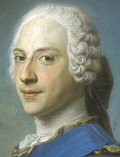 |
Charles Edward Louis John Casimir Silvester Maria
b. 20/31 Dec 1720, Rome, Papal States
d. 30 (or 31) Jan 1788, Rome |
| Title: |
Regent of the Kingdoms of Scotland, England, France and Ireland, and the dominions thereunto belonging |
| Term: |
23 Jul/3 Aug 1745 - 20 Sep/1 Oct 1746 |
|
12/23 Dec 1743, appointed by Royal Commission under Sign Manual and Privy Signet, Rome, Papal States (renewed 25 Jul/5 Aug 1750) [1] |
|
23 Jul/3 Aug 1745, started to exercise regental authority upon landing at the island of Eriskay in the Outer Hebrides, Scotland [2] |
|
17/28 Sep 1745, proclaimed as regent for James VIII in Edinburgh [3] |
|
20 Sep/1 Oct 1746, ceased to exercise regental authority upon departing the British Isles at Borrodale, Lochaber, Scotland [4][5] |
| Names/titles: |
Baptised (20/31 Dec 1720): Charles Edward Louis John Casimir Silvester Maria [6]; private name: Charles Edward Louis John Casimir Silvester Maria Stuart; bynames: Bonnie Prince Charlie, the Young Pretender; |
|
Prince of Wales and Earl of Chester [as claimant: 20/31 Dec 1720 - 1 Jan 1766]; was also known as Baron Renfrew, Count of Albany; |
|
Dei gratia Anglie Scotie Francie et Hibernie Rex, Fidei Defensor, etc. = By the grace of God, King of England, Scotland, France and Ireland, Defender of the Faith, etc. (alternatively for Scotland: Dei gratia Scotie Anglie Francie et Hibernie Rex, Fidei Defensor, etc. = By the grace of God, King of Scotland, England, France and Ireland, Defender of the Faith, etc.) as Charles III [as claimant: 1 Jan 1766 - 30 or 31 Jan 1788] |
| Biography: |
| Elder son of James Francis Edward Stuart and of his wife, Maria Clementina Sobieska (Maria Klementyna Sobieska); spent his young years mostly in Rome and Bologna; participated in the siege of Gaeta (1734); was appointed regent (12/23 Dec 1743) by his father unable to mount an expedition for restoration of the Stuarts in Britain; landed first at Eriskay Island in the Outer Hebrides (23 Jul/3 Aug 1745), finally disembarking in mainland Scotland at Borrodale, Lochaber, by 25 Jul/5 Aug 1745; raised the Jacobite standard at Glenfinnan (19/30 Aug 1745) and entered Edinburgh (17/28 Sep 1745), where his father was proclaimed King as James VIII; defeated the governmental army at the Battle of Prestonpans (21 Sep/2 Oct 1745); entered England after crossing the River Esk (8/19 Nov 1745) and progressed as far as Derby (4/15 Dec 1745); finding no substantial support, returned to Scotland, where his army was utterly defeated in the Battle of Culloden (16/27 Apr 1746); fled to the Highlands where he was wandering for six months; went aboard a French ship (19/30 Sep 1746) and departed for the Continent (20 Sep/1 Oct 1746); lived mostly in France; protested against the Treaty of Aix-la-Chapelle which had confirmed the British claims of the House of Hanover (1748); succeeded to all of his father's British rights upon the death of the latter (1 Jan 1766) and took up residence in Rome; failed to receive papal recognition of his titles.
|
| Biographical sources: "The Last Stuart: The Life and Times of Bonnie Prince Charlie", by David Daiches (New York: Putnam, 1973). |
| |
| [1] |
History of the Transactions in Scotland, 38-39. |
| [2] |
Itinerary of Princes Charles Edward Stuart, 1. |
| [3] |
Itinerary of Princes Charles Edward Stuart, 15. |
| [4] |
Itinerary of Princes Charles Edward Stuart, 70. |
| [5] |
20 Sep/1 Oct 1746 is purely a notional date as Prince Charles could hardly exercise any authority after defeat of his troops in the Battle of Culloden (16/27 Apr 1746). |
| [6] |
These are the actual names as recorded in baptismal certificate kept at Windsor. See Stuart Papers at Windsor, 60. Several others were considered by his father who made a long list. Other sources add Philip as one of the names given at birth. |
|
Image: portrait by Maurice Quentin de la Tour. |

